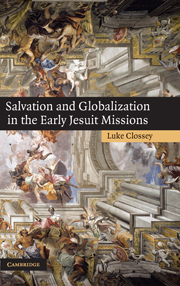Book contents
- Frontmatter
- Contents
- List of Tables and Charts
- Acknowledgments
- 1 Introduction
- 2 Organizing the Society of Jesus
- 3 Decentralizing the Society of Jesus
- 4 Imagining Global Mission
- 5 Space, Time, and Truth in the Jesuit Psychology
- 6 The Missionary Motivation
- 7 The Jesuit Missionary Network
- 8 The Jesuit Financial Network
- 9 The Jesuit Information Network
- 10 The Jesuit Sacred Economy
- 11 An Edifying End: Global Salvific Catholicism
- Appendix A Abbreviations for Document Sources
- Appendix B Chronological Tables (1540–1722)
- Appendix C Principal Prosographical Information
- Appendix D Monetary Systems
- Works Cited
- Index
5 - Space, Time, and Truth in the Jesuit Psychology
Published online by Cambridge University Press: 28 July 2009
- Frontmatter
- Contents
- List of Tables and Charts
- Acknowledgments
- 1 Introduction
- 2 Organizing the Society of Jesus
- 3 Decentralizing the Society of Jesus
- 4 Imagining Global Mission
- 5 Space, Time, and Truth in the Jesuit Psychology
- 6 The Missionary Motivation
- 7 The Jesuit Missionary Network
- 8 The Jesuit Financial Network
- 9 The Jesuit Information Network
- 10 The Jesuit Sacred Economy
- 11 An Edifying End: Global Salvific Catholicism
- Appendix A Abbreviations for Document Sources
- Appendix B Chronological Tables (1540–1722)
- Appendix C Principal Prosographical Information
- Appendix D Monetary Systems
- Works Cited
- Index
Summary
Understandings of distance are not uniform. A modern alternative approach to distance comes with topology, the study of the nonquantitative properties of geometric spaces. The iconic topological schematic is the tube map of the London Underground, revealing which lines connect to which, without specifying how many kilometres separate you from Stockwell station. In late-medieval Europe distance could be understood in a similarly fluid way, and the schema of the London Underground finds distant cousins in the programs of medieval sacred art, with their relative scales, curious metrics, and iconographical wormholes. The fifteenth century came to know a “finite, spatially referenced spherical earth, a tabula rasa on which the achievements of exploration could be cumulatively inscribed,” where measured distance became more geographical than iconographical. Wolfgang Schivelbusch has described the mental annihilation of space brought about in the nineteenth century as railways overtook stagecoaches, travelling at three times the speed; here we witness a yet more significant revolution. Instead of lands moving three times closer, we see lands previously existing in conjecture and legend being drawn onto the map itself.
In addition, the still-developing global map warped understandings of geography, most strikingly in the idea that New Spain was close to China, a misconception residual of the miscalculations of Columbus, who had underestimated the distance between Japan and the Canary Islands by two-thirds.
- Type
- Chapter
- Information
- Salvation and Globalization in the Early Jesuit Missions , pp. 90 - 113Publisher: Cambridge University PressPrint publication year: 2008



